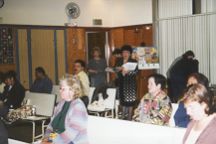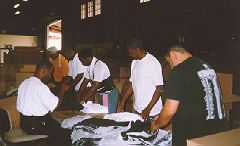 |
2000 Best Practice Awards"Local" Winners:
Los Angeles Area Office
2000-793 Citizen Participation in Diverse
Communities
Glendale, California
Moises Carrillo (818) 548-2060
The City of Glendale's Consolidated Planning
process includes consultation with public and private agencies, community
coalitions, City departments, social service agencies, and  community
residents. The City's main emphasis is on direct citizen participation
involving diverse cultural and ethnic groups. The sources of direct community
input included: three public meetings in low income neighborhoods that
were divided into a total of eight focus groups involving 84 participants,
a community needs questionnaire targeted to low income neighborhoods, an
economic development needs survey mailed out to 900 businesses and completed
by 50 businesses, a city wide community needs telephone, and a public hearing
discussion group involving 51 residents. The City also produced a 15-minute
info-mercial broadcast on the City's cable station to provide education
about the CDBG program and to encourage residents to announce upcoming
community meetings and to call in their comments. Through these means,
a total of 1,234 residents provided direct input into the City's Consolidated
Plan. community
residents. The City's main emphasis is on direct citizen participation
involving diverse cultural and ethnic groups. The sources of direct community
input included: three public meetings in low income neighborhoods that
were divided into a total of eight focus groups involving 84 participants,
a community needs questionnaire targeted to low income neighborhoods, an
economic development needs survey mailed out to 900 businesses and completed
by 50 businesses, a city wide community needs telephone, and a public hearing
discussion group involving 51 residents. The City also produced a 15-minute
info-mercial broadcast on the City's cable station to provide education
about the CDBG program and to encourage residents to announce upcoming
community meetings and to call in their comments. Through these means,
a total of 1,234 residents provided direct input into the City's Consolidated
Plan.
2000-2419 Crime and Safety Unit, Housing
Authority for the County of Los Angeles (HACoLA)
Monterey Park, California
Maria C. Badrakhan (323) 890-7135
The Crime and Safety Unit (CSU) was formed
in 1997 to serve support the creation and sustainability of safer and healthier
communities. The CSU has developed a variety of crime prevention, intervention,
enforcement, and community organization and outreach programs, similar
to a housing authority police department. These programs include community
policing, criminal investigations, Neighborhood Watch, Human Relations,
and Crime Prevention Through Environmental Design (CPTED). In implementing
the programs, the CSU has also facilitated the creation of close relationships
and communication among a wide range of community members, particularly
among law enforcement agencies, HACoLA staff, and public housing residents.
2000-1939 West "A" Homes
Los Angeles, California
Sandra M. Speed (323) 732-4333
This is a 44-unit multifamily housing development
located in South Central Los Angeles. It is  part of "new" developments that combine
a variety of social services with a "smart" design. All of the
units are wired for internet access and all of the residents will receive
a computer. This is a faith based community development corporation that
wants to ensure that each resident have access to job training, financial
literacy and to ensure that their children would be enrolled in one of
the best afterschool tutorial programs in the country, L.A.'s Best. part of "new" developments that combine
a variety of social services with a "smart" design. All of the
units are wired for internet access and all of the residents will receive
a computer. This is a faith based community development corporation that
wants to ensure that each resident have access to job training, financial
literacy and to ensure that their children would be enrolled in one of
the best afterschool tutorial programs in the country, L.A.'s Best.
2000-897 Asian Pacific Islander (API) Housing
Collaborative
Los Angeles, California
Josh Ishimatsu (213) 473-1691
A collaborative project of the Housing and
Economic Development Committee of the Asian Pacific Policy and Planning
Council (hereafter A3PCON HED), this collaborative,
originally named the API Capacity Building Program, was formed in 1996
to enhance the ability of Asian Pacific Islander (API) community-based
organizations (CBOs) to carry out sustainable development activities in
their respective communities. Beneficiaries of this program included 15
CBOs in API communities throughout the greater Los Angeles area, who received
technical assistance in organizational capacity development, site analysis,
feasibility studies, business loans and financial packaging.
2000-1422 Housing Integrity Compliance
Program
Glendale, California
Reinaldo T. Vargas (818) 548-3722
This initiative provides effective accountability
and  measurable
benefits to address fraud in the Section 8 rental subsidy program. Successes
have reinvented the organization, recovered funds through Court prosecutions,
and placed public trust and stewardship of public funds as core responsibilities
in the agency's operations. The program is successfully diverting assistance
from fraudulent participants to serve the people it was intended to serve
using the agency's scarce resources of Section 8 vouchers. measurable
benefits to address fraud in the Section 8 rental subsidy program. Successes
have reinvented the organization, recovered funds through Court prosecutions,
and placed public trust and stewardship of public funds as core responsibilities
in the agency's operations. The program is successfully diverting assistance
from fraudulent participants to serve the people it was intended to serve
using the agency's scarce resources of Section 8 vouchers.
2000-2116 Good Neighbor Program
Paramount, California
Jose Gomez (562) 220-2200
The Good Neighbor Program consists of two
major elements: Element 1 - Solicit the property owners/landlords in the
target area for participation in the program. Element 2 - GNP Certification
The second major element involves landlord certification in the GNP. The
objective of the Program is to reduce crime in the Target Area by giving
property owners and managers the tools necessary to develop a safer and
more desirable living environment for tenants. The GNP Team consists of
members from Public Safety, the District Attorney's Office, Sheriff's Dept.,
Code Enforcement, Building and Safety, Housing Authority, Health Department
and the Fire Dept.
2000-1574 Shelter Resource Bank
Los Angeles, California
Ruth Schwartz (213) 688-2188
 |
Shelter Partnership works to secure new goods
or excess inventory and counterfeit and confiscated goods that would normally
be sold to discount chains, destroyed or shipped overseas. They receive
donations from corporations such as Avon, Clorox, Gillette, Kimberly-Clark
and Lever Brothers, as well as many small companies. (During 1999, we received
goods valued at over $10 million.) These donors give for a variety of reasons
– excess quantities were produced, the goods are seasonal, errors occurred
in labeling the products, expiration dates (such as with pens) are too close
to put in stores, or purely for philanthropic purposes. Quarterly,  a list of available goods is sent to agencies that
have been pre-qualified to participate. These agencies order the goods that
they need, in the quantities needed. Then, based on availability and appropriateness
of the request, goods are allocated to each agency. a list of available goods is sent to agencies that
have been pre-qualified to participate. These agencies order the goods that
they need, in the quantities needed. Then, based on availability and appropriateness
of the request, goods are allocated to each agency. |
2000-2230 Nueva Maravilla Central High
School - Alternative School
Monterey Park, California
Maria C. Badrakhan (323) 890-7135
Central High School – Alternative School
is a collaborative approach of various professional and community agencies
that help provide a network of support for the students and their families.
Before each student is admitted to the program, he/she and their parents
are interviewed to assure that the program is an appropriate placement
for the student, and to solicit parental support. The small class size
of a maximum of 25 students between the ages of 16 and 21 years assures
that the instructor is able to provide and monitor an individualized course
of studies based on the student’s level. Also, it assures that the
students will receive significant one-on-one instruction that is not given
at the local overpopulated, understaffed public High School.
2000-1296 Neighborhoods Partner Program
Long Beach, California
Martha C. Villacres (562) 570-6658
The City of Long Beach Neighborhood Partners
Program (NPP) assists a variety of improvements and beautification projects
within Federal Community Development Block Grant (CDBG) eligible neighborhoods.
Applicants, which must be established neighborhood/community organizations,
are encouraged to be creative. Projects must have a public benefit, and
must have support of the organization's governing body and the affected
neighborhood. Projects may include tree plantings or landscape projects,
adopting and improving neighborhood parks or schools, creating community
gardens/landscaped open space, community youth projects, neighborhood brochures,
banners, and community murals. Projects involving construction, substantial
rehabilitation, and/or public roadway improvements are not eligible. Eligible
projects are required to comply with applicable building, fire, safety,
health, traffic, and zoning regulations of the City and all Federal regulations
governing the CDBG program. Eligible groups must be formally established
organizations having designated officers and membership rosters and a history
of neighborhood involvement. The NPP will provide matching grants of up
to $5,000 in goods and services to accomplish approved projects. The match
provided by the applicant must be equal to at least 50% of the total project
cost and may be supplied in the form of cash, goods and services, and volunteer
work hours.
2000-3142 Santa Monica/Westside Continuum
of Care
Santa Monica, California
Joel Schwartz (310) 458-8701
Santa Monica is one of the first cities in
the nation to link twenty-two homeless service programs through a shared
computerized case management system, a network which includes outreach
programs, case management in a variety of settings (shower/locker programs,
emergency shelter, transitional housing, Shelter Plus Care programs), programs
for special populations (the mentally ill, with programs specifically targeting
mentally ill women; the substance-addicted and dual-diagnosed; seniors;
veterans; the AIDS/HIV-affected; families; emancipated youth), job training
and employment placement, substance abuse and mental health services, legal
aid and aftercare support including counseling, peer mentoring and job
retention programs.
2000-2859 Public Housing Training For Law
Enforcement
Monterey Park, California
Maria C. Badrakhan (323) 890-7135
The Housing Authority of the County of Los
Angeles teamed with the Los Angeles County Sheriff's Department to educate
law enforcement personnel about public housing and the Section 8 program.
The Los Angeles Sheriff's Department received a grant from the Office of
Community Oriented Policing Services - U.S. Department of Justice to develop
training programs through a Regional Community Policing Institute.
2000-2878 Reggie Rodriguez Community Center
Montebello, California
Dolores Gonzalez-Hayes (323) 887-1390
The Reggie Rodriguez Community Center is
one of several Lohart Neighborhood Revitalization Project goals as determined
by the neighborhood's 900+ low-income residents. The Community Center will
not only provide a place to meet but will become the heart of the neighborhood.
Lohart, once known for disinvestment and lack of heighborhood pride, is
now aneighborhood where its residents have hope and have taken control
of their neighborhood. The residents have worked to design a revitalization
plan, rid the neighborhood of gang influence and have become a model for
other neighborhoods still plagued with social and economic problems. A
unique approach to neighborhood revitalization is the formation of partnerships.
The development of a community center is an example of the type of accomplishments
that partnerships can achieve. The Lohart partnership includes federal,
state, county, non-profit and public sector inovlvement, and most importantly
the neighborhood residents.
2000-3011 Business Technology Center of
Los Angeles County
Monterey Park, California
Christy A. Miyagishima (323) 890-7437
The Community Development Commission of Los
Angeles County nominates its Business Technology Center project for a HUD
Best Practices Award. The Business Technology Center (BTC) is a high technology
business incubator. The BTC is a 40,000 square foot high technology business
incubator. It is the largest high technology incubator in California and
the only high technology incubator in the nation owned and operated by
a county agency. The mission of the BTC is job creation by assisting start-up
and early stage high technology firms. A second goal of the BTC project
is to spark development in the West Altadena Redevelopment Project Area.
The third goal is to assist in the creation of the San Gabriel Valley Technology
Corridor.
2000-3017 The Telemedicine Program in Public
Housing (TPPH)
Schoolteachers always just assumed he was
a "problem learner." That’s the debilitating label that
was applied to the adolescent public housing resident who had trouble keeping
up with his peers. When the teenager, however, received an eye examination
at the Carmelitos Telemedicine Center, doctors discovered that he had an
easily correctable vision problem. After being treated, the once struggling
student was able to stay the course with his classmates.
The Telemedicine Program in Public Housing
was created with people like this teenager in mind - those without a lot
of money who live in urban communities often underserved by medical care.
To improve access to health care, the Community Development Commission/Housing
Authority of the County of Los Angeles (CDC/HACoLA) partnered with the
Charles R. Drew University of Medicine and Science in 1996 tolaunch the
Telemedicine Program in Public Housing. Using advanced telecommunications
technology, the Telemedicine Program provides public housing residents
with on-site access to early diagnosis and treatment of sight-threatening
diseases.
2000-3119 Microloan Intermediary Program
(LACDB)
Los Angeles, California
Dave Eder (213) 485-0783
Provide microloans ($1,000 to $25,000) to
very small businesses (5 or fewer employees), home based businesses and
recent startups (1-2 years experience) utilizing a network of lending intermediaries.
This program can be replicated and is designed to make effective utilization
of existing small business/microlending and technical assistance programs
to outreach to the diverse small businesses of the empowerment zone.
2000-2286 Community Development Block Grant
Program, Program Requirements - Drawdown Ratio
Monterey Park, California
Carlos Jackson (323) 890-7400
The Community Development Commission (CDC)
of the County of Los Angeles is the County’s affordable housing and
community and economic development agency. One of numerous programs operated
by the CDC is the Community Development Block Grant (CDBG) Program. The
Program covers all unincorporated areas of Los Angeles County, serving
2.2 million people, and includes 48 participating cities, making it the
largest Urban County CDBG Program in the nation. One of the requirements
imposed by the U. S. Department of Housing and Urban Development (HUD)
on the CDBG Program concerns the timeliness of spending. As of May 1, 1999),
the County’s timeliness ratio was .74 Program Years of funds on hand.
This ratio fell well within the 1.50 ratio as required by HUD.
To effectively manage the drawdown of funds,
the County holds all participating cities to the same standard that HUD
holds its grantees. The allocation method entitles each of the participating
cities and County Districts to funding, as allocations are made and distributed
based on population, poverty (weighted twice), and overcrowded housing
units. This allocation method provides a level of certainty that funds
can be anticipated for the upcoming year, allowing effective planning for
project implementation on July 1.
2000-432 Hotel de Riviera
Santa Barbara, California
Susan Boehije (805) 963-9644
The beautiful historic Hotel de Riviera located
in downtown Santa Barbara is now a supportive transitional housing facility
for dually diagnosed persons with substance abuse problems and mental health.
The hotel contains 30 rooms, and the program is serving approximately 35
residents. The 24-month program provides housing and supportive services,
such as mental health casework, recovery services, enhanced life skills
training, and work training. At the completion of the program "graduates"
are assisted with permanent housing.
2000-3065 My Front Door
Los Angeles, California
Chas. Belknap (213) 413-1130
Homeownership for the Disabled. My Front
Door is a subsidiary for the Los Angeles County Mental Health Association,
which works with persons with stabilized mental illness to assist them
to attain home ownership. Staff works with the client to attain the budgeting
and living skills necessary for home ownership. They assist them in finding
properties and in lining up secondary financing. The project benefits from
a continued relatively soft condominium market. Analysis shows that their
clients receiving a Social Security disability allocation or greater are
able to afford regular housing payments, generally in an amount which can
cover maintenance and association dues.
My Front Door staff is trained in homeownership
counseling and is able to help the client to negotiate the real estate
deal and to obtain first-time homebuyer subsidies. In addition, My Front
Door is able to place clients by buying properties and selling them to
clients in a rent-to-own program. Condominium life has many advantages
for these people who have experienced mental illnesses. It offers the advantages
of homeownership without some of the onerous tasks (and costs) of maintenance.
The condominium association also offers the opportunity to socialize.
Return to
Best Practices 2000 Winners List
Content Archived: April 20, 2011 |